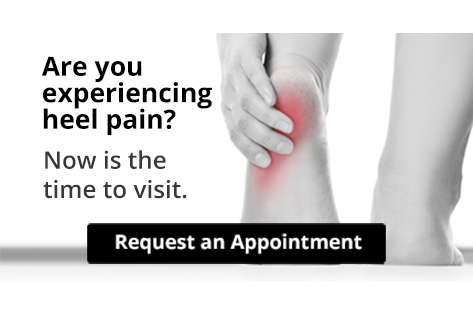Connect With Us
Blog
Items filtered by date: February 2021
Runners And Blisters On The Feet
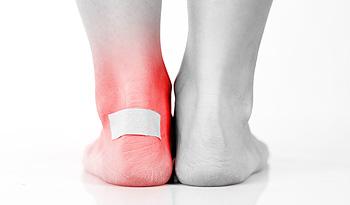 People who enjoy running can experience blisters. It is the body’s method of protecting skin that has become damaged from excessive friction. It appears as a bubble that is filled with liquid which forms over the raw skin, and it will gradually drain as new skin develops. It is beneficial to wear a protective covering over the blister while running, and this may help to prevent the blister from popping or draining prematurely. Common symptoms of an infected blister can consist of swelling, redness, and there may be a yellowish fluid that comes from the blister. Effective preventive methods can include wearing shoes and socks that fit correctly, and it may help to improve balance which can affect stability. If you would like additional information about blisters on the feet, please confer with a podiatrist.
People who enjoy running can experience blisters. It is the body’s method of protecting skin that has become damaged from excessive friction. It appears as a bubble that is filled with liquid which forms over the raw skin, and it will gradually drain as new skin develops. It is beneficial to wear a protective covering over the blister while running, and this may help to prevent the blister from popping or draining prematurely. Common symptoms of an infected blister can consist of swelling, redness, and there may be a yellowish fluid that comes from the blister. Effective preventive methods can include wearing shoes and socks that fit correctly, and it may help to improve balance which can affect stability. If you would like additional information about blisters on the feet, please confer with a podiatrist.
Blisters are prone to making everyday activities extremely uncomfortable. If your feet are hurting, contact Dr. Howard Horowitz of Bowie Foot & Ankle . Our doctor can provide the care you need to keep you pain-free and on your feet.
Foot Blisters
Foot blisters develop as a result of constantly wearing tight or ill-fitting footwear. This happens due to the constant rubbing from the shoe, which can often lead to pain.
What Are Foot Blisters?
A foot blister is a small fluid-filled pocket that forms on the upper-most layer of the skin. Blisters are filled with clear fluid and can lead to blood drainage or pus if the area becomes infected.
How Do Blisters Form?
Blisters on the feet are often the result of constant friction of skin and material, usually by shoe rubbing. Walking in sandals, boots, or shoes that don’t fit properly for long periods of time can result in a blister. Having consistent foot moisture and humidity can easily lead to blister formation.
Prevention & Treatment
It is important to properly care for the affected area in order to prevent infection and ease the pain. Do not lance the blister and use a Band-Aid to provide pain relief. Also, be sure to keep your feet dry and wear proper fitting shoes. If you see blood or pus in a blister, seek assistance from a podiatrist.
If you have any questions, please feel free to contact our office located in Bowie, MD. We offer the newest diagnostic and treatment technologies for all your foot care needs.
Read more about BlistersRunners And Blisters On The Feet
 People who enjoy running can experience blisters. It is the body’s method of protecting skin that has become damaged from excessive friction. It appears as a bubble that is filled with liquid which forms over the raw skin, and it will gradually drain as new skin develops. It is beneficial to wear a protective covering over the blister while running, and this may help to prevent the blister from popping or draining prematurely. Common symptoms of an infected blister can consist of swelling, redness, and there may be a yellowish fluid that comes from the blister. Effective preventive methods can include wearing shoes and socks that fit correctly, and it may help to improve balance which can affect stability. If you would like additional information about blisters on the feet, please confer with a podiatrist.
People who enjoy running can experience blisters. It is the body’s method of protecting skin that has become damaged from excessive friction. It appears as a bubble that is filled with liquid which forms over the raw skin, and it will gradually drain as new skin develops. It is beneficial to wear a protective covering over the blister while running, and this may help to prevent the blister from popping or draining prematurely. Common symptoms of an infected blister can consist of swelling, redness, and there may be a yellowish fluid that comes from the blister. Effective preventive methods can include wearing shoes and socks that fit correctly, and it may help to improve balance which can affect stability. If you would like additional information about blisters on the feet, please confer with a podiatrist.
Blisters are prone to making everyday activities extremely uncomfortable. If your feet are hurting, contact Dr. Howard Horowitz of Bowie Foot & Ankle . Our doctor can provide the care you need to keep you pain-free and on your feet.
Foot Blisters
Foot blisters develop as a result of constantly wearing tight or ill-fitting footwear. This happens due to the constant rubbing from the shoe, which can often lead to pain.
What Are Foot Blisters?
A foot blister is a small fluid-filled pocket that forms on the upper-most layer of the skin. Blisters are filled with clear fluid and can lead to blood drainage or pus if the area becomes infected.
How Do Blisters Form?
Blisters on the feet are often the result of constant friction of skin and material, usually by shoe rubbing. Walking in sandals, boots, or shoes that don’t fit properly for long periods of time can result in a blister. Having consistent foot moisture and humidity can easily lead to blister formation.
Prevention & Treatment
It is important to properly care for the affected area in order to prevent infection and ease the pain. Do not lance the blister and use a Band-Aid to provide pain relief. Also, be sure to keep your feet dry and wear proper fitting shoes. If you see blood or pus in a blister, seek assistance from a podiatrist.
If you have any questions, please feel free to contact our office located in Bowie, MD . We offer the newest diagnostic and treatment technologies for all your foot care needs.
What Are Orthotics?
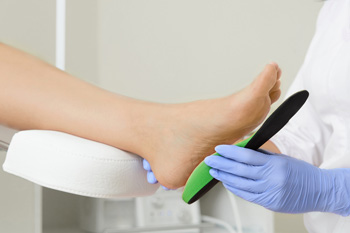 Orthotics are inserts that are worn inside of the shoes to correct issues with foot deformities, foot alignment, or to relieve pressure from various foot conditions. Orthotics can help relieve foot pain, knee pain, and lower back pain as well. There are 3 common types of orthotics including: soft, rigid, and semi-rigid. Soft orthotics are designed to cushion the foot when planted on the ground. Semi-rigid orthotics are designed to provide a middle ground between stability and cushioning and are often used for patients with flat feet. Rigid orthotics are designed to control movement in the foot that causes pain. If you believe that orthotics may be right for you, please consult with a podiatrist for professional advice. A podiatrist will custom make your orthotics to maximize your experience.
Orthotics are inserts that are worn inside of the shoes to correct issues with foot deformities, foot alignment, or to relieve pressure from various foot conditions. Orthotics can help relieve foot pain, knee pain, and lower back pain as well. There are 3 common types of orthotics including: soft, rigid, and semi-rigid. Soft orthotics are designed to cushion the foot when planted on the ground. Semi-rigid orthotics are designed to provide a middle ground between stability and cushioning and are often used for patients with flat feet. Rigid orthotics are designed to control movement in the foot that causes pain. If you believe that orthotics may be right for you, please consult with a podiatrist for professional advice. A podiatrist will custom make your orthotics to maximize your experience.
If you are having discomfort in your feet and would like to try orthotics, contact Dr. Howard Horowitz from Bowie Foot & Ankle . Our doctor can provide the care you need to keep you pain-free and on your feet.
What Are Orthotics?
Orthotics are inserts you can place into your shoes to help with a variety of foot problems such as flat feet or foot pain. Orthotics provide relief and comfort for minor foot and heel pain but can’t correct serious biomechanical problems in your feet.
Over-the-Counter Inserts
Orthotics come in a wide variety of over-the-counter inserts that are used to treat foot pain, heel pain, and minor problems. For example, arch supports can be inserted into your shoes to help correct overarched or flat feet, while gel insoles are often used because they provide comfort and relief from foot and heel pain by alleviating pressure.
Prescription Orthotics
If over-the-counter inserts don’t work for you or if you have a more severe foot concern, it is possible to have your podiatrist prescribe custom orthotics. These high-quality inserts are designed to treat problems such as abnormal motion, plantar fasciitis, and severe forms of heel pain. They can even be used to help patients suffering from diabetes by treating foot ulcers and painful calluses and are usually molded to your feet individually, which allows them to provide full support and comfort.
If you are experiencing minor to severe foot or heel pain, it’s recommended to speak with your podiatrist about the possibilities of using orthotics. A podiatrist can determine which type of orthotic is right for you and allow you to take the first steps towards being pain-free.
If you have any questions please contact our office located in Bowie, MD. We offer the newest diagnostic and treatment technologies for all your foot and ankle needs.
Read more about Foot OrthoticsWhat Are Orthotics?
 Orthotics are inserts that are worn inside of the shoes to correct issues with foot deformities, foot alignment, or to relieve pressure from various foot conditions. Orthotics can help relieve foot pain, knee pain, and lower back pain as well. There are 3 common types of orthotics including: soft, rigid, and semi-rigid. Soft orthotics are designed to cushion the foot when planted on the ground. Semi-rigid orthotics are designed to provide a middle ground between stability and cushioning and are often used for patients with flat feet. Rigid orthotics are designed to control movement in the foot that causes pain. If you believe that orthotics may be right for you, please consult with a podiatrist for professional advice. A podiatrist will custom make your orthotics to maximize your experience.
Orthotics are inserts that are worn inside of the shoes to correct issues with foot deformities, foot alignment, or to relieve pressure from various foot conditions. Orthotics can help relieve foot pain, knee pain, and lower back pain as well. There are 3 common types of orthotics including: soft, rigid, and semi-rigid. Soft orthotics are designed to cushion the foot when planted on the ground. Semi-rigid orthotics are designed to provide a middle ground between stability and cushioning and are often used for patients with flat feet. Rigid orthotics are designed to control movement in the foot that causes pain. If you believe that orthotics may be right for you, please consult with a podiatrist for professional advice. A podiatrist will custom make your orthotics to maximize your experience.
If you are having discomfort in your feet and would like to try orthotics, contact Dr. Howard Horowitz from Bowie Foot & Ankle . Our doctor can provide the care you need to keep you pain-free and on your feet.
What Are Orthotics?
Orthotics are inserts you can place into your shoes to help with a variety of foot problems such as flat feet or foot pain. Orthotics provide relief and comfort for minor foot and heel pain but can’t correct serious biomechanical problems in your feet.
Over-the-Counter Inserts
Orthotics come in a wide variety of over-the-counter inserts that are used to treat foot pain, heel pain, and minor problems. For example, arch supports can be inserted into your shoes to help correct overarched or flat feet, while gel insoles are often used because they provide comfort and relief from foot and heel pain by alleviating pressure.
Prescription Orthotics
If over-the-counter inserts don’t work for you or if you have a more severe foot concern, it is possible to have your podiatrist prescribe custom orthotics. These high-quality inserts are designed to treat problems such as abnormal motion, plantar fasciitis, and severe forms of heel pain. They can even be used to help patients suffering from diabetes by treating foot ulcers and painful calluses and are usually molded to your feet individually, which allows them to provide full support and comfort.
If you are experiencing minor to severe foot or heel pain, it’s recommended to speak with your podiatrist about the possibilities of using orthotics. A podiatrist can determine which type of orthotic is right for you and allow you to take the first steps towards being pain-free.
If you have any questions please contact our office located in Bowie, MD . We offer the newest diagnostic and treatment technologies for all your foot and ankle needs.
Heel Pain Can Be Treated!
Heel Pain Can Be Treated!
Prevention Tips for Athlete's Foot
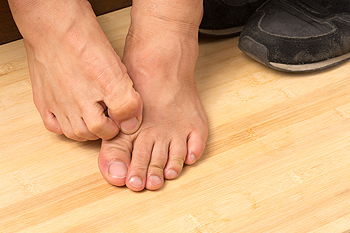 Athlete’s foot is a fungal infection of the skin on the feet that can cause a scaly, itchy rash to develop between your toes. This infection is contagious and is often contracted by walking barefoot in damp places, such as showers, public swimming pools, and locker rooms, or from sharing personal items with an infected individual. To prevent athlete’s foot, it is recommended that you keep your feet clean and dry, wear clean socks, avoid walking barefoot in public areas, and keep your toenails clean and trimmed. It is also important to refrain from sharing personal items like socks and towels with an infected individual. If you suspect that you may have athlete’s foot, it is suggested that you consult with a podiatrist for treatment.
Athlete’s foot is a fungal infection of the skin on the feet that can cause a scaly, itchy rash to develop between your toes. This infection is contagious and is often contracted by walking barefoot in damp places, such as showers, public swimming pools, and locker rooms, or from sharing personal items with an infected individual. To prevent athlete’s foot, it is recommended that you keep your feet clean and dry, wear clean socks, avoid walking barefoot in public areas, and keep your toenails clean and trimmed. It is also important to refrain from sharing personal items like socks and towels with an infected individual. If you suspect that you may have athlete’s foot, it is suggested that you consult with a podiatrist for treatment.
Athlete’s foot is an inconvenient condition that can be easily reduced with the proper treatment. If you have any concerns about your feet and ankles, contact Dr. Howard Horowitz from Bowie Foot & Ankle . Our doctor will treat your foot and ankle needs.
Athlete’s Foot: The Sole Story
Athlete's foot, also known as tinea pedis, can be an extremely contagious foot infection. It is commonly contracted in public changing areas and bathrooms, dormitory style living quarters, around locker rooms and public swimming pools, or anywhere your feet often come into contact with other people.
Solutions to Combat Athlete’s Foot
- Hydrate your feet by using lotion
- Exfoliate
- Buff off nails
- Use of anti-fungal products
- Examine your feet and visit your doctor if any suspicious blisters or cuts develop
Athlete’s foot can cause many irritating symptoms such as dry and flaking skin, itching, and redness. Some more severe symptoms can include bleeding and cracked skin, intense itching and burning, and even pain when walking. In the worst cases, Athlete’s foot can cause blistering as well. Speak to your podiatrist for a better understanding of the different causes of Athlete’s foot, as well as help in determining which treatment options are best for you.
If you have any questions please feel free to contact our office located in Bowie, MD. We offer the newest diagnostic and treatment technologies for all your foot and ankle needs.
Read more about Athlete's FootPrevention Tips for Athlete's Foot
 Athlete’s foot is a fungal infection of the skin on the feet that can cause a scaly, itchy rash to develop between your toes. This infection is contagious and is often contracted by walking barefoot in damp places, such as showers, public swimming pools, and locker rooms, or from sharing personal items with an infected individual. To prevent athlete’s foot, it is recommended that you keep your feet clean and dry, wear clean socks, avoid walking barefoot in public areas, and keep your toenails clean and trimmed. It is also important to refrain from sharing personal items like socks and towels with an infected individual. If you suspect that you may have athlete’s foot, it is suggested that you consult with a podiatrist for treatment.
Athlete’s foot is a fungal infection of the skin on the feet that can cause a scaly, itchy rash to develop between your toes. This infection is contagious and is often contracted by walking barefoot in damp places, such as showers, public swimming pools, and locker rooms, or from sharing personal items with an infected individual. To prevent athlete’s foot, it is recommended that you keep your feet clean and dry, wear clean socks, avoid walking barefoot in public areas, and keep your toenails clean and trimmed. It is also important to refrain from sharing personal items like socks and towels with an infected individual. If you suspect that you may have athlete’s foot, it is suggested that you consult with a podiatrist for treatment.
Athlete’s foot is an inconvenient condition that can be easily reduced with the proper treatment. If you have any concerns about your feet and ankles, contact Dr. Howard Horowitz from Bowie Foot & Ankle . Our doctor will treat your foot and ankle needs.
Athlete’s Foot: The Sole Story
Athlete's foot, also known as tinea pedis, can be an extremely contagious foot infection. It is commonly contracted in public changing areas and bathrooms, dormitory style living quarters, around locker rooms and public swimming pools, or anywhere your feet often come into contact with other people.
Solutions to Combat Athlete’s Foot
- Hydrate your feet by using lotion
- Exfoliate
- Buff off nails
- Use of anti-fungal products
- Examine your feet and visit your doctor if any suspicious blisters or cuts develop
Athlete’s foot can cause many irritating symptoms such as dry and flaking skin, itching, and redness. Some more severe symptoms can include bleeding and cracked skin, intense itching and burning, and even pain when walking. In the worst cases, Athlete’s foot can cause blistering as well. Speak to your podiatrist for a better understanding of the different causes of Athlete’s foot, as well as help in determining which treatment options are best for you.
If you have any questions please feel free to contact our office located in Bowie, MD . We offer the newest diagnostic and treatment technologies for all your foot and ankle needs.
Treatment for Flexible and Rigid Hammertoes
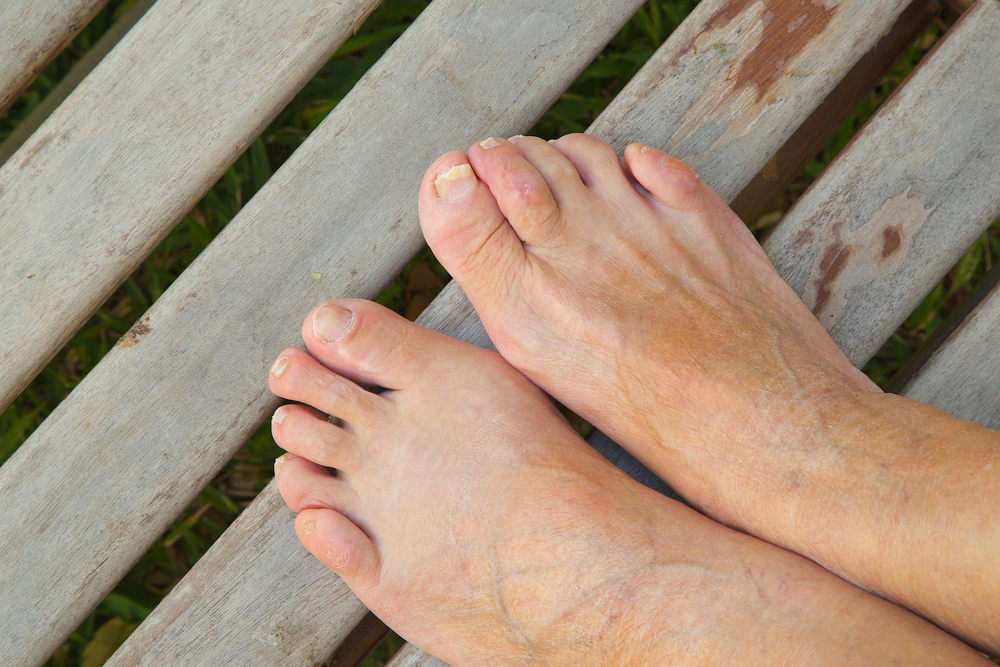 Hammertoes are a foot deformity in which one or more of the smaller toes are bent at the middle joint, resulting in a hammer-like appearance. In the early stages of this condition, the hammertoes are usually flexible and the patient can move their toe joints. Flexible hammertoes can often be treated without surgery. Changing your footwear, doing toe strengthening exercises, and putting a pad over the joint to stop it from rubbing against the shoes can all help relieve symptoms. Having rigid hammertoes means that the toe joints are no longer movable. This can be treated conservatively through footwear modifications and custom orthotics, or surgically. For more information about hammertoes, please consult with a podiatrist.
Hammertoes are a foot deformity in which one or more of the smaller toes are bent at the middle joint, resulting in a hammer-like appearance. In the early stages of this condition, the hammertoes are usually flexible and the patient can move their toe joints. Flexible hammertoes can often be treated without surgery. Changing your footwear, doing toe strengthening exercises, and putting a pad over the joint to stop it from rubbing against the shoes can all help relieve symptoms. Having rigid hammertoes means that the toe joints are no longer movable. This can be treated conservatively through footwear modifications and custom orthotics, or surgically. For more information about hammertoes, please consult with a podiatrist.
Hammertoe
Hammertoes can be a painful condition to live with. For more information, contact Dr. Howard Horowitz from Bowie Foot & Ankle . Our doctor will answer any of your foot- and ankle-related questions.
Hammertoe is a foot deformity that affects the joints of the second, third, fourth, or fifth toes of your feet. It is a painful foot condition in which these toes curl and arch up, which can often lead to pain when wearing footwear.
Symptoms
- Pain in the affected toes
- Development of corns or calluses due to friction
- Inflammation
- Redness
- Contracture of the toes
Causes
Genetics – People who are genetically predisposed to hammertoe are often more susceptible
Arthritis – Because arthritis affects the joints in your toes, further deformities stemming from arthritis can occur
Trauma – Direct trauma to the toes could potentially lead to hammertoe
Ill-fitting shoes – Undue pressure on the front of the toes from ill-fitting shoes can potentially lead to the development of hammertoe
Treatment
Orthotics – Custom made inserts can be used to help relieve pressure placed on the toes and therefore relieve some of the pain associated with it
Medications – Oral medications such as anti-inflammatories or NSAIDs could be used to treat the pain and inflammation hammertoes causes. Injections of corticosteroids are also sometimes used
Surgery – In more severe cases where the hammertoes have become more rigid, foot surgery is a potential option
If you have any questions please contact our office located in Bowie, MD. We offer the newest diagnostic and treatment technologies for all your foot and ankle needs.
Read more about HammertoeTreatment for Flexible and Rigid Hammertoes
 Hammertoes are a foot deformity in which one or more of the smaller toes are bent at the middle joint, resulting in a hammer-like appearance. In the early stages of this condition, the hammertoes are usually flexible and the patient can move their toe joints. Flexible hammertoes can often be treated without surgery. Changing your footwear, doing toe strengthening exercises, and putting a pad over the joint to stop it from rubbing against the shoes can all help relieve symptoms. Having rigid hammertoes means that the toe joints are no longer movable. This can be treated conservatively through footwear modifications and custom orthotics, or surgically. For more information about hammertoes, please consult with a podiatrist.
Hammertoes are a foot deformity in which one or more of the smaller toes are bent at the middle joint, resulting in a hammer-like appearance. In the early stages of this condition, the hammertoes are usually flexible and the patient can move their toe joints. Flexible hammertoes can often be treated without surgery. Changing your footwear, doing toe strengthening exercises, and putting a pad over the joint to stop it from rubbing against the shoes can all help relieve symptoms. Having rigid hammertoes means that the toe joints are no longer movable. This can be treated conservatively through footwear modifications and custom orthotics, or surgically. For more information about hammertoes, please consult with a podiatrist.
Hammertoe
Hammertoes can be a painful condition to live with. For more information, contact Dr. Howard Horowitz from Bowie Foot & Ankle . Our doctor will answer any of your foot- and ankle-related questions.
Hammertoe is a foot deformity that affects the joints of the second, third, fourth, or fifth toes of your feet. It is a painful foot condition in which these toes curl and arch up, which can often lead to pain when wearing footwear.
Symptoms
- Pain in the affected toes
- Development of corns or calluses due to friction
- Inflammation
- Redness
- Contracture of the toes
Causes
Genetics – People who are genetically predisposed to hammertoe are often more susceptible
Arthritis – Because arthritis affects the joints in your toes, further deformities stemming from arthritis can occur
Trauma – Direct trauma to the toes could potentially lead to hammertoe
Ill-fitting shoes – Undue pressure on the front of the toes from ill-fitting shoes can potentially lead to the development of hammertoe
Treatment
Orthotics – Custom made inserts can be used to help relieve pressure placed on the toes and therefore relieve some of the pain associated with it
Medications – Oral medications such as anti-inflammatories or NSAIDs could be used to treat the pain and inflammation hammertoes causes. Injections of corticosteroids are also sometimes used
Surgery – In more severe cases where the hammertoes have become more rigid, foot surgery is a potential option
If you have any questions, please feel free to contact our office located in Bowie, MD . We offer the newest diagnostic and treatment technologies for all your foot care needs.
